Archive for the 'Fruit' Category
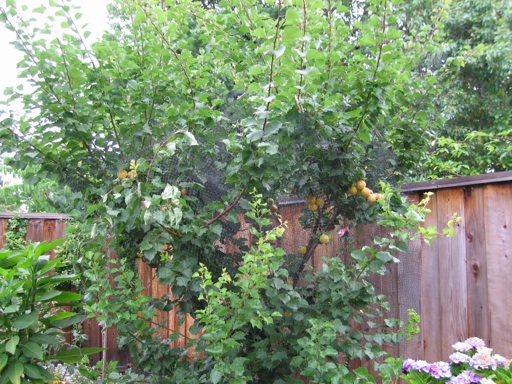
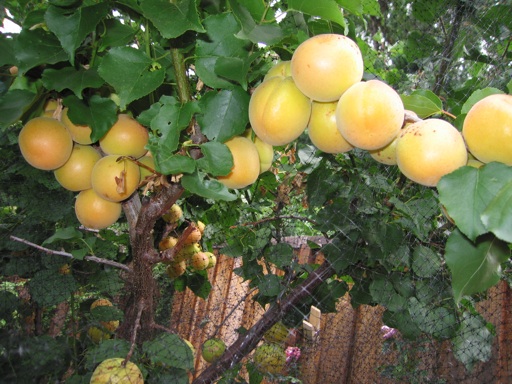
Yesterday, my mom came over to our house to help me harvest my first batch of Blenheim apricots of the year from the above pictured tree in our yard. We both love the taste of tree ripened Blenheim apricots. They seem to be the most flavorful apricot. My parents have a 30+ year old Blenheim apricot tree in their yard that is still producing quality fruit.
My tree is now 7 years old. Its fruit are large and have a very good flavor. They are much better tasting than the grocery store apricots I have eaten. Although, we both think that the fruit from my parents’ 30+ year old tree is much sweeter than the fruit from my young tree. Their apricots taste like a dessert. My guess is that a mature apricot tree has a greater ability than a young tree to generate sugars and produce sweeter fruits.
I have had to build a virtual fortress of bird netting around my apricot tree to keep the birds and squirrels from eating the fruit. So far, I have lost only a few fruits to the wildlife. I wrapped bird netting around all sides of the tree up to the upper weak branches and then tied it tightly around the bottom with string leaving no openings around the sides or the bottom for the squirrels to crawl through. I loosely draped the netting through the high branches to keep the birds from flying inside. This netting technique has mostly kept the bird and squirrels out.
A few days ago, I peeled away the netting to pick a few apricots and then didn’t reseal the netting tightly enough after I was finished. By the time I was back inside our kitchen, a squirrel had already found its way inside the netting. After shooing it away, I wrapped two extra nets around the tree for a total of 3 nets. There hasn’t been any more breaches since then. The two week period when apricots are ripening in late June and early July is the most important time to net. That’s when the birds and squirrels seem to to go after them the most.
July 02 2009 | Apricots | Comments Off on Harvesting Blenheim Apricots

I planted the corn in this picture back in mid-April when it was about two inches high. Corn has been one of the fastest growing plants in our raised bed vegetable garden this year. It has grown particularly fast in the past month. It is already about four feet tall, even though it’s getting crowded by nearby tomato and bean plants that I planted the corn too close to. The fastest growing plants in our garden this year have been pole beans (behind the corn in the picture), corn, tomatoes, and zucchini.
I planted a sweet white variety of corn this year. I tend to prefer the white corn varieties over the yellow corn varieties, because I have found that white corn is usually sweeter. Last year, I grew a bi-colored yellow and white corn variety which turned out to be very flavorful and buttery.
Our tomatoes and beans are also growing vigorously and crowding our nearby peppers and eggplants. The peppers and eggplants haven’t been growing very much. I think that’s because they are not getting enough sun. Perhaps, they don’t have enough root space either. I really underestimated how large some of these fruit/vegetables would get. Next year, I will try to have more restraint by setting out fewer plants.
June 28 2009 | Corn | Comments Off on Fast Growing Corn


I planted several new fruit trees earlier this year in our yard, including an almond, another peach, a nectarine, a plum, and 2 more cherries. I sometimes hear people say that fruit trees take too many years to produce fruit. For them, I have three words: plums, peaches, and nectarines. All three typically bear fruit by their second year in the ground.
I planted a 4 variety multi-grafted plum tree in February. It already has dozens of plums (see first picture above). Most of the plums are hidden behind the leaves in this picture. The 4 varieties are beauty, nubiana, laroda, and elephant heart. They ripen in June, July, August, and September, respectively, for a 4 four month long plum season. I have already eaten several of the beauty plums, and they are good, with just a little tartness in the skin. Plums produce fruit at a young age. Although my tree wasn’t a new bare root tree when I bought it. It looked like it had been in a pot at least a year.
The other new fruit trees I planted as bare root trees. They don’t have any fruit this year, but they are growing vigorously. The second picture shows the new nectarine (snow queen) in the foreground and the new peach (snow beauty) in the back right. The peach and nectarine trees will likely have their first crop of fruit next summer. Peaches and nectarines produce fruit on branches that grew during the previous year. They also produce fruit at an early age like plums.
I found that one of the keys to growing fruit trees successfully is giving them a regular supply of water and not letting their root systems dry out at any time. In our dry climate, that means regular watering. I have micro-spray devices on all of our fruit trees that are controlled by an automatic watering system. They get watered for about 5 minutes every other day through the spring and summer months. I have found that this schedule keeps the roots moist without over-watering during normal conditions here. During hot weather (90 degrees plus), I water them everyday and/or for a longer time.
Some people are lucky enough to live in climates that get rain on and off throughout the spring and summer months. Last month, I visited family in Kentucky. The small fruit orchard in their backyard includes two peach trees. One of the things I noticed was that the leaves of their peach trees were a pale green color, and they were not actively growing new leaves. The leaves were not a healthy looking deep green like the leaves of our peach trees in California.
My first thought was that they looked like they were not getting enough water. The ground around the trees looked dried out. That seemed strange, because I was told that it had rained a lot in early May before we arrived. Apparently, the sun dries out the ground quickly there too in the late spring.
I have noticed that when fruit trees like peaches don’t get enough water for several days or weeks, the leaves tend to turn pale, and they stop growing. I think that it begins to happen as soon as the roots dry out, which probably happens a lot sooner in young trees that have small roots systems. The lesson I have taken from my experiences is that it is important to prevent the root systems of young fruit trees from drying out, so that they continue to grow through the spring and summer. That’s particularly important for newly planted trees.
Even in Kentucky were it rains frequently through the spring and summer, it’s possible that peaches and other fruit trees can dry out after a week or more without a significant downpour. I was told that nobody bothers to water their outdoor plants in Kentucky, because they feel that there is no need to. But perhaps they should consider supplemental watering during dry spells.
June 21 2009 | Cherries and Peaches/Nectarines and Plums | Comments Off on New Fruit Trees
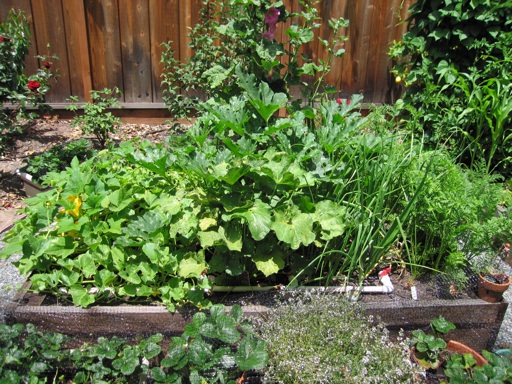
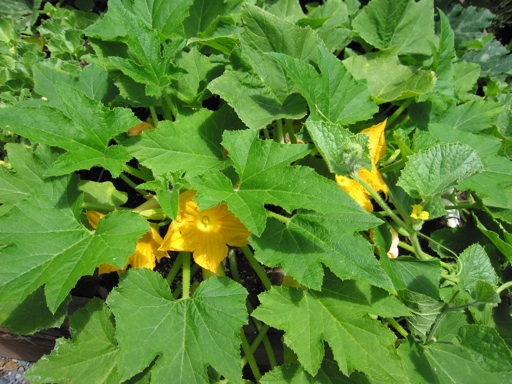
One of the things that I enjoy most about gardening is watching plants grow and produce. Fruits and vegetables that are annuals grows especially fast. For example, the green zucchini I planted back in mid-March as a 3 inch tall transplant has now grown so large, it is taking over one of the raised beds in our vegetable garden (see middle of top picture). It is crowding the onions and cantaloupe I planted nearby. I have trimmed off some of its leaves to stop it from shading nearby plants.
Apparently, I put too many plants in this 6′ x 7′ raised bed. But with only two small raised beds for growing vegetables, it’s hard to sacrifice some of the plants that I want to grow. A single cluster of only two green zucchini plants needs a lot of space. They are producing so many zucchinis I am giving some away.
The yellow zucchini that I planted in mid-April is a much more manageable size so far (see bottom picture and far left of top picture). It is producing less than half as many zucchinis as the green one. I have decided that two clusters of zucchini plants produces too many zucchinis for two people to eat, unless you want to have zucchini for dinner nearly everyday. I am more inclined to make a vegetable stir fry with zucchini once or twice a week. Next year, I am going to plant only one cluster of yellow zucchini because of its more compact size, and I will not plant any green zucchini.
June 14 2009 | Zucchini | Comments Off on Zucchinis Taking Over
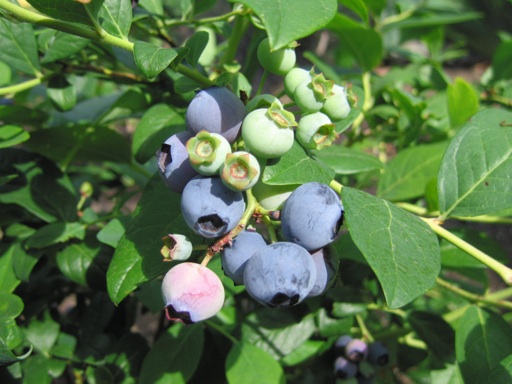
Blueberry season is here in Northern California. I have been growing southern highbush blueberries in the ground in our backyard for about three years now. I am growing the varieties Misty, O’Neal, Southmoon, Jubilee, and Sunshine. The above picture is our O’Neal bush.
Our blueberries have produced berries every year and have grown relatively well. They haven’t grown very fast or very large. They are only about two feet tall and about as wide. That puzzles me, because I have read that these varieties are supposed to reach 6 feet tall, except Sunshine which is a compact variety. I am not sure how long it would take to reach their full height or even if they are capable of doing so in our climate.
I don’t seem to be having a problem with soil pH, even though our soil tested at a pH of about 6.5. Blueberries are supposed to prefer a soil pH of about 5.5. The leaves of all 6 of our bushes look green and healthy, and the blueberries are very tasty. Each bush usually gets 50-100 berries. I have given them a sulfur additive once or twice a year and an occasional treatment of acidic water soluble fertilizer.
The main problem I have had with blueberries is birds eating the berries. The birds have eaten our berries as soon as they begin to turn blue. I have seen birds eating or attempting to eat the berries several times a day.
I have covered each of our bushes with bird netting to try to stop them. At first, the netting didn’t work very well. The birds just crawled under the netting or picked the berries right through the netting. They ate a significant percentage of the berries even with the bird netting covering the bushes. About a week ago, I added extra netting, tucked the netting tightly under each bush, and held the netting to the ground with large rocks. This configuration seems to be working well at keeping them from eating the berries.
The problem is that the berries are hard to pick now. Each time I want to pick the berries I have to go through the trouble of removing the netting from each bush and then recovering each bush well enough so that the birds can’t get in after I am finished.
I am already thinking about devising a better system that perhaps I could implement by next year. It would be much easier to have a wooden frame covered with chicken wire around each bush that could be easily removed and replaced to facilitate harvesting. Maybe I will have them built by next summer.
June 07 2009 | Blueberries | Comments Off on Blueberry Season
« Prev - Next »







